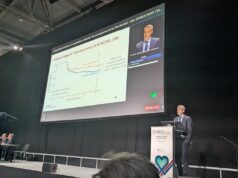 As per late-breaking research presented recently at the 2024 European Society of Cardiology (ESC) congress (30 August–2 September, London, UK), cryoballoon (CB) ablation is as effective at reducing recurrences of atrial fibrillation (AF) and atrial tachycardia (AT) at one year when compared to the most widely used technique—radiofrequency (RF) ablation—in heart failure patients with a reduced ejection fraction (HFrEF).
As per late-breaking research presented recently at the 2024 European Society of Cardiology (ESC) congress (30 August–2 September, London, UK), cryoballoon (CB) ablation is as effective at reducing recurrences of atrial fibrillation (AF) and atrial tachycardia (AT) at one year when compared to the most widely used technique—radiofrequency (RF) ablation—in heart failure patients with a reduced ejection fraction (HFrEF).
The CRABL-HF study also found that CB ablation has the added benefit of being able to be performed with a shorter procedure time and less fluid volume during catheter ablation without increasing left atrium pulse pressure, indicating that the risk of worsening heart failure due to infusion load during ablation may be reduced.
“AF catheter ablation is increasingly performed worldwide in patients with heart failure, but is associated with increased risks of procedure-related complications and death,” explained CRABL-HF lead investigator Koji Miyamoto (National Cerebral and Cardiovascular Center, Suita, Japan). “Yet, [few] data exist on which of the most widely used ablation techniques best improves clinical outcomes, survival and quality of life.
“Our results show that CB ablation—a minimally invasive procedure that freezes out disruptive heart cells—is faster but as effective as the commonly used approach of burning the cells in order to put the heart back into a normal rhythm pattern. In addition, there was a very low risk of procedural complications in both groups, demonstrating that catheter ablation has become much safer over the years.”
The most widely used technique for AF ablation is RF ablation, which uses heat to destroy the tissue causing the heart rhythm disturbance. However, its technical complexity demands a relatively long learning curve and procedure time. CB technology, which involves guiding a small tube into the heart to kill problematic tissue with cold temperatures, has been utilised to simplify the procedure.
“While there have been several trials comparing RF ablation and CB ablation in patients with both heart failure and AF, none have prospectively compared the outcome between CB and RF ablation,” Miyamoto continued. “There is an urgent need to generate high-quality evidence to guide clinical-decision-making for these ablation procedures in patients with HFrEF.”
For the CRABL-HF trial, researchers enrolled 110 patients with HFrEF and AF, aged 20–85 years, at five sites across Japan. Some 55 of these patients were randomised to receive RF ablation while the other 55 underwent CB ablation. The median age was 69 years and 79% of patients were men in this cohort.
In patients with cardiac implantable electronic devices, home monitoring was adapted to allow the continuous monitoring of AF episodes. In patients without cardiac implantable electronic devices, ambulatory electrocardiograms (ECGs) were recorded twice daily for one year after the procedure—subsequent to a blanking period of 90 days.
Miyamoto and colleagues ultimately found that, one year after the procedure, there was no significant difference in rates of atrial tachyarrhythmias lasting 30 seconds or more, with these occurring in 21.8% of patients receiving RF ablation and 22.2% of CB patients.
Additionally, CB ablation was able to be performed with a significantly shorter procedure time (median, 101 minutes) compared to RF ablation (median, 165 minutes), as well as less fluid volume during cryoablation without leading to an increase in left atrial (LA) pulse pressure, indicating that the risk of worsening heart failure due to infusion load during ablation may be reduced.
The left ventricular ejection fraction (LVEF)—a measure of how well the left ventricle of the heart pumps with each contraction—improved, while the left arterial volume index (LAVI)—a measure of the volume of the left atrium divided by the body surface area—decreased significantly after the procedure in both groups, resulting in improved heart function.
There were also no significant differences in the overall safety profile of the two techniques. Procedure-related complications occurred in one patient in each group: a retroperitoneal haematoma in the CB group and an arteriovenous fistula in the RF group. No procedure-related exacerbation of heart failure, symptomatic cerebral infarctions, transient ischaemic attacks, pulmonary valve (PV) stenosis, atrio-oesophageal fistulas, or procedure-related deaths, were noted.
In addition, during the one-year follow-up period, there were two deaths—one in each group. There were also seven cases of hospitalisations due to heart failure, including three patients (5.5%) in the CB group and four (7.3%) in the RF group. There was no difference in the composite endpoints of death from any cause and/or heart failure hospitalisations between the two groups.
There were also no significant differences in patient-reported quality of life, measured via the Atrial Fibrillation Effect on Quality of Life questionnaire (AFEQT) at one year, which improved after ablation in both groups (CB group, 68 [60–78] at baseline and 88 [80–94] at one year; RF group, 72 [56–81] at baseline and 90 [84–97] at one year).
“The underlying pathophysiology differs between patients with and without HFrEF, and the fundamental mechanisms of catheter ablation differ between CB and RF,” Miyamoto stated. “As our trial has shown that clinical outcomes and quality of life are similar after CB, this simplified procedure should be warranted to treat AF in most patients with HFrEF.”









